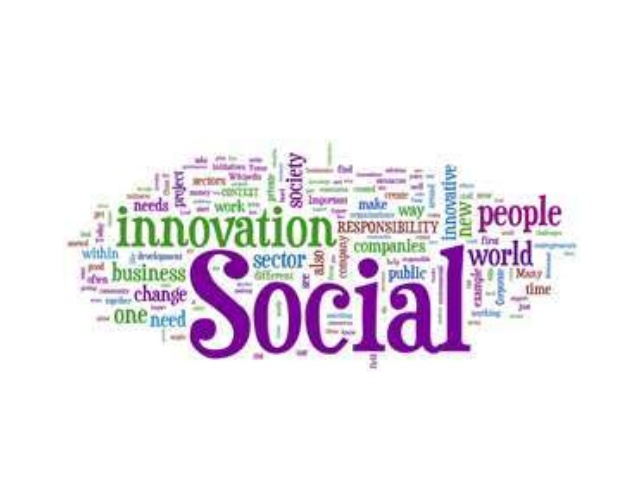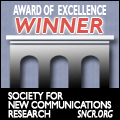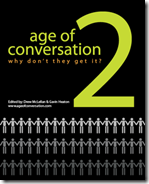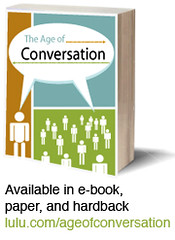In the past decade, our work at Creative Sage™ has become increasingly focused on innovation, workplace culture and social change, and we have moved into creativity and innovation program design and management, consulting, coaching and training, as well as content creation (print and digital). I have also recently joined the founding team for a new organization, Women Who Innovate, which you can read about here.
I am often asked: “But is your company still doing public relations, marketing and social media projects? Do you still do fundraising and event production?”
The answer is yes, with some qualifications. Since 2009, when we won a SNCR (Society for New Communications Research) Award for a groundbreaking social media healthcare project, along with our client, Sutter Health (affiliate Eden Medical Center), and collaborating partner, g2comm, Inc., and then participated in an innovative Live Earth climate change social media campaign, and worked on fundraising events and a Rotary International partnership with the Give Foundation, among many other notable healthcare, educational, philanthropic, and “social good” projects, I have become increasingly passionate about contributing to cultural and social change by taking on more client projects that fulfill this mission. Instead of thinking of ourselves as a marketing, public relations, social or digital “agency,” our company is intensively purpose-driven, focused on the larger picture of being part of a “woven network” of social and cultural innovators with a variety of backgrounds and skill sets that are driving transformational results.
Does this mean we are only working on nonprofit projects? Are we still working on small business and larger-scale corporate enterprise projects?
Yes to both, plus we work with socially innovative entrepreneurs, intrapreneurs, and project teams — whether they are at small businesses, mid-to-large size companies, at a nonprofit or trade association, civic, government, healthcare, or educational institution. The form and structure doesn’t matter — it’s that they are doing something beneficial for their communities, on a local and/or global scale, while increasing their brand integrity and bottom-line profits.
In a recent article at Huffington Post, by Alexandre Mars, “Stop Differentiating Social Entrepreneurs,” Mars writes:
Entrepreneurship is an approach and a mindset.
We need to be clear that regardless of whether it is technological or social entrepreneurship, it is the same community of entrepreneurs. Breaking through this gap is crucial in fostering more partnerships and collaboration between entrepreneurs across government, business, and the social sector.
What we especially support is innovation and collaboration across sectors — because at Creative Sage™, we believe that is where we can help produce and facilitate the most effective solutions and impact. This is the conclusion many social innovators are reaching — in a recent article in the Stanford Social Innovation Review, “Time for the Plural Sector,” author Henry Mintzberg states:
When one sector of society becomes dominant—as the public sector did under communism and the private sector is now doing in the name of capitalism—societies go out of balance and people suffer. A healthy society requires a respected public sector, a responsible private sector, and a robust plural sector. Calling it “plural,” in place of inadequate labels like nonprofit or third, will help this sector take its rightful place alongside the other two and also help us to appreciate the unique role it has to play in restoring that balance.
The social innovation or “social good” initiatives by large companies are still known as “Corporate Social Responsibility” or CSR, and they often emphasize “sustainability,” meaning both in the environmental and business senses. Often started to improve corporate relations with a surrounding community, or for branding and marketing purposes, companies that create authentic, purpose-driven CSR programs that make a real impact genuinely achieve social impact; and such programs contribute to employee retention.
The CSR Wire, Huffington Post Impact, and other web sites regularly cover CSR programs that work effectively, and they include cross-sector, or “Plural Sector” initiatives that have included collaborations with nonprofit agencies, government, education, health care and other types of organizations.
We support Millennials and upcoming younger generations choosing to pursue their passions, in a purpose-driven career that increasingly includes entrepreneurship — which can especially mean social entrepreneurship (or intrapreneurship in an already existing company). As Eric Poirier writes at TechCrunch, in a post entitled, “A Closer Look at the Silicon Valley vs. Wall Street Talent War“:
Simply put, the tech sector is where millennials feel they can make the most impact. It’s where innovation happens and outside-the-box thinking is part of the current zeitgeist. Be it transitioning from an Ivy League campus to the Google campus or joining an up-and-coming startup with a chance to become the next big thing, the tech sector has clearly surpassed finance as the more appealing career path for many graduates of top institutions, even if the average tech salary falls short of those offered by most financial institutions.
More than salary, they want to be impactful: a part of building something new, or changing the fundamental nature of a given process. Financial services is generally seen as one of the more traditional, if not lucrative, industries within the broader market — but it’s rare that you see the words “innovative” or “agile” mentioned in context with a large financial institution in the way that you do with a Google, Apple, Facebook or any host of small startups.
An increasing number of these startups are examples of “Social Entrepreneurship,” meaning their mission emphasizes the triple bottom line of profits, purpose and sustainability. If we want to continue to support social innovation locally or globally, our work projects must be aligned with this vision, and they are often multi-generational. As we have seen, many older people are not simply retiring, they are using their most cherished talents to pursue their purpose-driven encore career as a way to keep contributing, which can take the form of a social entrepreneurship, nonprofit leadership, or a new job at a company that practices CSR principles.
Some of our projects have involved cause marketing, fundraising and philanthropy in various forms, including crowd funding, individual donor campaigns, direct mail and social media fundraising strategies, creating marketing and fundraising partnerships between organizations, helping to develop or support new philanthropy initiatives, or doing more traditional grant writing. Although this is more often a component and not the main focus of our work, we have noticed some interesting research and posts lately, about how different generations give, as donors.
In a recent post at Thin Difference, “Influence: Giving and Leading across Generations,” by Jon Mertz, he emphasizes that millennials are not only giving money to good causes — and leading them — but they are also volunteering for social good initiatives at work in record numbers, comparable to the boomer generation. Mertz states:
Last week, the research group Achieve, sponsored by the Case Foundation, released the 2015 Millennial Impact Report. This report is one in a series and always delivers essential insights about the emerging generosity of Millennials, the largest generation.
Millennials, Statistics, and Giving
Within the 2015 Millennial Impact Report, there are many statistics and information to explore. As I read through the report, highlighted below are some statistics to think about as it relates to Millennials, giving, and influence.
Giving time and money
• 84% of Millennial employees made a charitable donation in 2014
• 70% of Millennial employees spent at least an hour volunteering in 2014.
• 37% volunteered up to 10 hours and 31% volunteered more than 11 hours
Giving and influence• 45% of those who volunteered said some of their time was promoted or made available by their company
• 27% of Millennial employees are more likely to donate to a cause if their supervisor does
• 40% of employees are likely to donate to a cause if their co-worker asks them
• 77% of Millennial employees prefer to volunteer with groups of fellow employeesMillennial giving: Mindset and Skills
• 79% of Millennial employees who do not participate in company-wide giving campaigns still donate outside of work
• 77% of Millennial employees are more likely to volunteer if they can use specific skills or expertise to benefit a causeInfluence and Leading: Generosity and Generations
There are some elements of this report that are encouraging and set the stage on how to gain greater meaning in the work we do.
The encouraging element is the fact Millennials are giving their time, money, and talent at rates comparable to older generations. In other words, Millennials are not waiting until later stages of their lives to give. A giving mindset is a wonderful way to begin work and community life.
The stage is set in how organizations can influence each other to achieve a greater good. Peers influence each other in giving money and contributing time. Managers and supervisors set an example that others will join in, especially when it comes to social good initiatives. When social good initiatives are encouraged by businesses, a certain passion is exposed and people feel good about their work, their company, and the impact they have.
In fact, leadership, business models, and the culture of the workplace is being tremendously influenced by millennials, who will not stay at your organization for long, unless you offer them meaning and a way to contribute purpose, along with a salary and decent benefits. As Jorge Barba writes in his post, “What the Leader of the Future Looks Like,” at Game Changer:
To deal with the challenge of this new workforce’s demands, the digitization of the enterprise, diversity, and thinking about the bigger picture, established companies are creating new roles; including the dreaded Chief Innovation Officer. And to bring the entrepreneurial mindset inside their four walls, some consultants are advising established companies to create a new role where an entrepreneur acts as visionary side-by-side with a traditional CEO; which is not so different from what many startups do to scale a company.
Many argue that we’re making a big deal about millennials influence on the workplace. Are we? I don’t think so. Every generation is different and thus has a different view of what they want the world to be. We, millennials, have a very different approach to getting work done as well as what it means to us; beyond just getting a paycheck.
At Creative Sage™, we may target specific generations or marketing and fundraising niches, and media in some of our projects — but for far-reaching social good projects, we prefer to be as inclusive, cross-generational and cross-sector as possible, in alignment with our clients’ specific goals.
What we are doing now is creating connections and networks that foster social innovation, social transformation, and make a real impact. We bring a different tool and skill set to each project, which can include our expertise in strategy, marketing, public relations, social media, community building, fundraising, event production, or content production (digital and print) — along with our innovation program design and management, training, consulting, coaching, and leadership skills — but overall, we are vitally excited about working on the most transformational, imaginative and socially innovative projects, as well as creating some of our own.
We are most passionate about collaborating across sectors and industries with clients who are ready to “push the edges” and truly innovate, not simply practice “business as usual.” Think about Creative Sage™ when you want to do something truly imaginative, dynamic, and remarkable, that makes a real impact. If that’s you, your organization, or another organization you know, then you should refer them to us.
For more information, contact us, and we’ll be glad to discuss your project, or a consulting, training or coaching engagement.
Please note: We’ll be at a Creative Sage™ retreat during the next few weeks, but we will receive email messages, if you send one to schedule a phone or Skype call after August 9, 2016. We’ll return in August to work on new company and client projects. We’ll continue to post here, and at What’s Innovation Got To Do with It? as well as at the new Women Who Innovate web site. Enjoy your summer, and watch for new announcements this fall!
[The articles mentioned in this post have been curated for our Creative Sage™ Tumblr Collection, where we'll resume posting new articles and resources when we return on August 9th.]
Return to the Cathryn Hrudicka & Associates Home Page

























